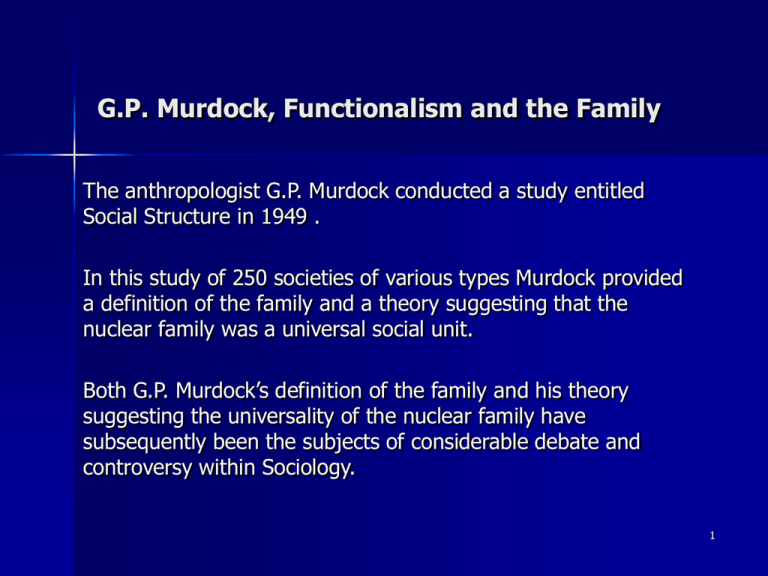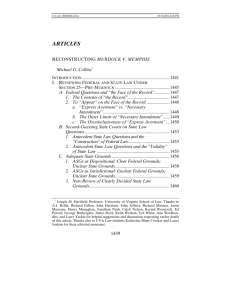
G.P. Murdock, Functionalism and the Family
The anthropologist G.P. Murdock conducted a study entitled
Social Structure in 1949 .
In this study of 250 societies of various types Murdock provided
a definition of the family and a theory suggesting that the
nuclear family was a universal social unit.
Both G.P. Murdock’s definition of the family and his theory
suggesting the universality of the nuclear family have
subsequently been the subjects of considerable debate and
controversy within Sociology.
1
G.P. Murdock, Functionalism and the Family
G.P. Murdock’s definition of the family:
A social group characterised by common residence, economic cooperation and
reproduction. It includes adults of both sexes at least two of whom maintain a
socially approved sexual relationship and one or more children, own or adopted,
of the socially cohabiting adults.
Murdock distinguished also between nuclear families[ parents and their children ,
own or adopted] and extended families [parents, children and other relatives].
Murdock argued also that “the nuclear family is a universal social grouping.
Either as the sole prevailing form of the family or as the basic unit from which
more complex forms are compounded, it exists as a unique and strongly
functional group in every known society”.
2
G.P. Murdock, Functionalism and the Family
Functionalist sociologists explain the existence of social institutions by the fact
that they fulfil functions essential for the continued harmonious existence of
society.
Thus factories and banks exist because the fulfil economic and financial
functions; schools fulfil educational functions; hospitals safeguard our health;
and so on.
In Functionalist terminology all of these institutions are said to be functional for
societies: that is: they contribute to the continuing social stability and harmony
of societies
3
G.P. Murdock, Functionalism and the Family
According to G. P. Murdock the family in general and the nuclear family are also
functional for society in that they fulfil the following essential functions.
The Sexual Function
The Reproductive Function
The Educational Function
The Economic Function
4
G.P. Murdock, Functionalism and the Family
According to G. P. Murdock these functions can be fulfilled especially well within
the nuclear family.
The existence of the nuclear family provides for stable, more or less permanent
heterosexual relationships between individual couples. If individuals were
involved in many fairly temporary sexual relationships such relationships might
be relatively emotionally shallow.
The nuclear family provides a stable environment increasing the likelihood that
there will be strong emotional bonds between parents and their children which
means that the socialisation of the children is more likely to be effective.
Economic roles within the nuclear family can be allocated effectively having
regard to the differing psychological and physical characteristics of males and
females respectively.
Murdock was a supporter of the traditional gender division of labour within
nuclear families
5
G.P. Murdock, Functionalism and the Family
The universal existence of nuclear families is also seen by Murdock to be in
accordance with what he believes to be the universal characteristics of human
nature.
Murdock believed that individuals naturally desire more less permanent
heterosexual relationships within which they can produce their own natural
children.
Adults gain fulfilment both from these heterosexual relationships and as a result
of the strong emotional bonds with their children which are sustained most easily
in the nuclear family.
These strong emotional bonds are conducive to the efficient socialisation of the
children.
Adult roles within the nuclear family can be allocated in accordance with natural
gender differences in physical and psychological characteristics.
6
G.P. Murdock, Functionalism and the Family
In G.P. Murdock’s definition of the family the family is based around socially
approved heterosexual relationships. These relationships may be based upon
monogamy, polygyny or polyandry.
“Socially approved” heterosexual relationships could refer to a relationship
based upon marriage or on cohabitation if it is socially approved in a given
society at a particular time.
Lone parents and their children would not be seen as families because they do
not contain two or more adults in an approved sexual relationship.
Childless heterosexual couples , married or cohabiting, would not be seen as
families.
Gay and lesbian couples, cohabiting or civil partnered, with or without children
would not be seen as families.
Friendship groups sharing a household would not be described as families .
7
G.P. Murdock, Functionalism and the Family
Some Criticisms of G.P. Murdock’s Theory
It is argued that several of the social groupings which would not be defined as
families under G.P. Murdock’s definition might nevertheless be reasonably
described as families.
It is argued that the nuclear family is not a universal social group and that the
essential functions of the family can be performed effectively in other family
forms.
In particular it is argued that children can be reared and socialised effectively in
lone parent families and many would argue that single sex couples also can
rear and socialise children effectively although others would dispute this.
You should also use your textbooks to familiarise yourselves with family forms
in other cultures. This diversity of family forms calls into question G.P.
Murdock’s assumption that the nuclear family reflects most closely the
requirements of human nature. Perhaps cultural diversity suggests that in
several respects no single fixed version of human nature exists in all societies.
Functions performed by families might also be performed in different ways in
Communes and Kibbutzim. Use your textbooks to research these.
8
G.P. Murdock, Functionalism and the Family
The American Functionalist sociologist Talcott Parsons has developed
theories which are similar in several respects to those of G.P. Murdock and
these theories will be considered in subsequent documents.
In this respect you should find especially useful the slide show presented by
Liam Greenslade of Mid Kent College
9






![The Politics of Protest [week 3]](http://s2.studylib.net/store/data/005229111_1-9491ac8e8d24cc184a2c9020ba192c97-300x300.png)



